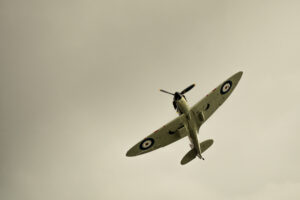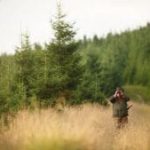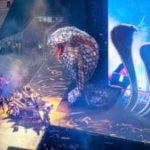
For several months in 1940, the Battle of Britain saw the nation’s air forces defend the country from German invasion. Life changed for many British school pupils during the war, including those at Repton School in Derbyshire.
An independent school founded in 1557, Repton has its fair share of fascinating history. The June 1940 issue of the School’s paper, The Reptonian, describes how “the very cradle of European civilisation” was “overrun by the iron-clad armies of the Nazis. All in France is unspeakably terrible. Yet here in Repton, in the middle of our ‘Island Fortress,’ all is still, serene, and peaceful.”
Let’s take a look at Repton School during the Second World War and remember the Old Reptonians who fought, and lost their lives, in the Battle of Britain.
Life at Repton School During the Second World War
Even before the outbreak of the Second World War, Repton’s Headmaster briefed staff on the School’s response in the event of an international crisis. When the war began, retired teachers returned to replace many of the School’s younger masters who had enlisted. Teachers wore gas masks, and those who forgot received a stern reprimand from the Headmaster.
Pupils swapped the traditional Repton uniform (straw hats and tailcoats) for more practical tweed suits in grey. In the summer of 1940, Repton welcomed evacuated pupils from King Edward’s School in Birmingham, amongst evacuees from other colleges, to board at homes in Repton village. Plus, one of the boys’ Houses, Old Mitre, served as accommodation for various RAF personnel. The School also received much of the Walker Art Gallery collection from Liverpool for safekeeping.
Repton School’s Labour Corps
Many air raid drills took place throughout the war in Repton School’s bomb shelter. Each House formed a fire squad, primed to defend the School against enemy action.
The School also operated a Labour Corps, with boys excused from the usual House matches to help on farms in the local area. Parked outside the Grubber for most of the first year of the war, a fighter aircraft provided an excellent training resource for the Corps’ air force segment.
The Labour Corps ran exercises, some of which proved unsuccessful. The master leading the Corps felt that boys might better learn concealment with the aid of live ammunition, perhaps “some sort of non-lethal bomb.” Thankfully, his theory went untested. Nevertheless, the boys acted quickly when a damaged Hurricane, in a garden behind the Orchard, burst into flames.
The Battle of Britain: Fallen Repton School Alumni
As the threat from Germany loomed over Britain, Repton School cancelled Speech Day. This was an unprecedented decision by the Headmaster, who drew up defence measures for the imminent invasion with Housemasters. To protect the armoury, the School also formed a Home Guard platoon.
The 1940 Summer Term ended two weeks into the Battle of Britain. While far removed from events on the South Coast, over the next few months, Repton School lost four former pupils to the war: Peter Drummond-Hay, Philip Barran, Robert Shaw, and Lionel Schwind.
1. Peter Drummond-Hay
A member of the Royal Air Force No. 609 Squadron, Drummond-Hay died during a patrol off Weymouth on July 9, 1940. Observing an attack on a convoy by some Junkers 87 Stuka dive-bombers, Drummond-Hay chased the attackers. He shot down a Messerschmitt 109 before enemy aircraft hit his Spitfire.
Drummond-Hay and his roommate David Crook, who had been on the same patrol, were planning a trip for their day off after a false alarm earlier that morning. Haunted by the idea of his friend at the bottom of the Channel, Crook moved to another cubicle on returning to base.
2. Philip Barran
Philip Barran joined the RAF at the outbreak of the Second World War. A pilot and founding member of the No. 609 Squadron, he died on July 11, 1940.
Following the detection of a signal by radar, Barran led a fleet of six Spitfires off the Dorset coast. They discovered a formation of Stukas on the verge of attacking a convoy. In the ensuing combat, Messerschmitts shot down Barran’s plane, and he bailed out five miles from shore. Rescuers retrieved Barran from the sea, but he died before they reached land.
3. Robert Shaw
A pilot officer in the RAF Volunteer Reserve, No. 1 Squadron, Shaw lost his life on September 3, 1940. The RAF had rolled out 729 sorties and 123 patrols to combat more than 600 enemy planes circling Kent.
Shaw died while intercepting enemy planes in his Hurricane. His body remains unrecovered, but many still honour his sacrifice at the memorial garden planted over the crash site.
4. Lionel Schwind
An RAF flying officer and a member of No. 213 Squadron and No. 257 Squadron during the Battle of Britain, Lionel Schwind died on September 27, 1940.
On that day, the RAF fought almost continuously as 640 German aircraft flew over Southern England in four consecutive formations. While on patrol, several Messerschmitts near Gatwick intercepted Schwind’s squadron and damaged the tail of the Hurricane he was piloting, causing it to catch fire. Unable to bail out of the burning aircraft, Schwind died as the plane hit the ground.
Schwind was due to attend a second wedding to his pregnant wife Georgina the next day (his father couldn’t attend the first ceremony).
Local Reptonians looked after the site of Schwind’s crash for years after his death. They would weed the area and place wildflowers from the surrounding woods at the foot of a beech tree.
We Will Remember Them
While Peter Drummond-Hay, Philip Barran, Robert Shaw, and Lionel Schwind lost their lives to the Battle of Britain, many other Old Reptonians, such as Innes Westmacott, John Rabone, and Ian Hallam, survived.
Flying up to four sorties per day, Hallam shot down one Messerschmitt and damaged three others. In 1942, after his plane was shot down over the El Alamein battlefield, Hallam spent three years in Stalag Luft III, a camp for prisoners of war. After the war, he continued his flying career but died in 1952 during a training flight.
In all, the Second World War claimed the lives of 189 Old Reptonians, 68 of whom served in the Royal Air Force. Many died during missions over Germany in the final years of the war. Repton School will not forget their sacrifices and continues to celebrate their lives.
About Repton School
Approximately 1,000 pupils attend Repton School and Repton Prep, which together form a through-school for pupils aged 3-18. Though large enough to offer excellent opportunities for pupils to compete internationally across sports, arts, and academics, Repton’s intimate size ensures that classes stay small. Repton’s committed teachers nurture each pupil, catering to their unique needs and helping them excel in all areas of the School’s broad curriculum.
Surrounded by the historic architecture of its Augustinian campus and beautiful grounds, Repton School offers state-of-the-art facilities. These include a multi-million-pound sports centre; a 315-seat theatre with industry-grade equipment; a science lab with an observatory; a lecture theatre housing a 3D screen; an art school with multiple galleries and a ceramics workshop; and a music school that boasts practice rooms, performance areas, and a recording studio.
Many Reptonians pursue degrees at top global universities and enjoy impressive and rewarding careers. Famous Repton School alumni include former Archbishop of Canterbury Michael Ramsey; presenter, author, and comedian Graham Garden OBE; actor Tom Chambers; and Olympic field hockey gold medallist Georgie Twigg.
Learn more about Repton School.
Read more:
Celebrating Old Reptonians Who Fought in the Battle of Britain






